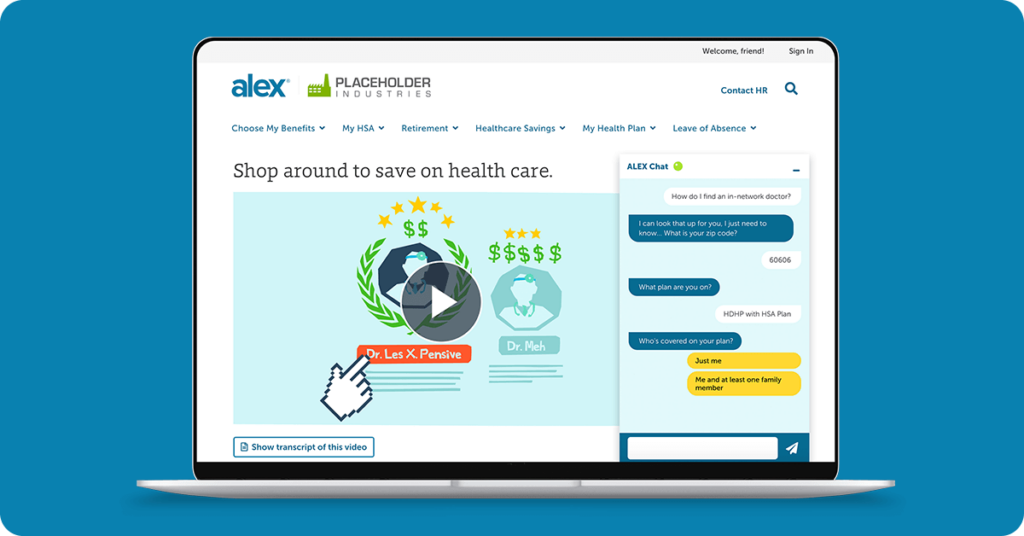Despite everything else in the world starting to slide towards a “new normal,” the pandemic shined a light on some things that shouldn’t return to status quo—employee benefits being one of them.
But despite your best efforts, in many cases, your employees aren’t happier, healthier or more engaged. In other words, where’s the ROI?
That’s why it’s time to reinvent benefits engagement. You’re spending a large portion of your time and budget on benefits, and you (and your people) need to get the most out of them. Combined with data from a Jellyvision survey of 1,000 full-time employees, this guide explains why the current approach to benefits isn’t working, and offers solutions for a better way forward.Section 01
The Problem: Employee Benefits are Broken
There’s no denying it, the world of employee benefits is in disrepair.
For starters, healthcare costs are on an unsustainable trajectory (nothing newsworthy there). But did you know a third of all money raised on GoFundMe goes towards healthcare expenses? Those are people reaching out to their community to crowdfund their health-related debts. What’s more, the top reason Americans file for bankruptcy is healthcare-related, confirmed by the fact that the medical debt is even higher than we thought. Does that sound like a system that’s working like a well-oiled machine? Or people that are supported by their healthcare coverage? Nope, not even a little!What This Means for HR professionals (i.e., Why You Should Care)
As an HR leader, you’re at the forefront of this battle. You’re also likely worried about your responsibilities to provide functional benefits and healthcare coverage to employees. Rightfully so, as you’re fighting against a large (often dysfunctional) system to provide support to individuals within it. Rock, meet the hard place. You’re not alone in these worries, either.Why You’re Fighting an Upstream Battle
Despite the stress and misgivings surrounding benefits, you’ve still been forced to, in essence, become a healthcare company.
You’re offering more benefits, solutions and plans than ever before in an effort to support employees. In fact, 98% of Jellyvision customers told us they’re expanding their benefits offerings in one way or another in response to the pandemic. 98%!!!
The sad irony here is that this ongoing battle isn’t bearing results. Your people aren’t any healthier, happier or more involved with their benefits. In fact, your efforts (and the collective healthcare situation) is having an adverse impact. More than half of employees (52%) are stressed out by benefits and another half of employees plan to leave their job this year.
And that’s exactly what we need to provide them! It’s just the matter of getting over the hump to provide on-demand benefits education and drive genuine benefits engagement, in spite of the countless roadblocks in the way for HR leaders.
Benefits engagement is done better with ALEX.
Section 02
Recognizing the Hard Truth: Our Beloved Benefits Communication Calendars and Employee Portals Are Partly to Blame
Alright y’all, this is going to be a hard pill to swallow.
But the first step to solving this mega problem is recognizing our well-loved methods (i.e., calendar-based benefits communication and employee portals), are no longer working. We know—you hate to hear it. But those traditional takes on benefits communication simply fail to get your people what they need, when they need it. Now, before you throw your benefits communications plan out the window, let’s pause. We’re not saying portals and benefits communications are bad. They certainly are not. In fact, we believe they’re an important component of your overall benefits strategy. But they just aren’t enough. They can’t be the only method of driving benefits engagement. Here are three reasons why leaning solely on these conventional methods is failing you, and why it’s time to evolve:1. Employees Don’t Celebrate Healthcare Holidays
Think about it, your current tactics deliver messages based on calendar or business needs. Like emails during (somewhat irrelevant holidays like) Healthy Lung Month. Those messages and that timing doesn’t speak to your employees, especially not when they have a pressing need. (Hot tip: HR folks care about health-related holidays, employees do not). And it’s clear these types of calendar-based approaches don’t work:That means employees may skim those emails, but they’re not upping their 401k contributions just because it’s National 401k Day or scheduling a physical during Wellness Month. And if they’re not acting, that’s a problem.
2. HR’s Curse of Knowledge
HR speak is not widely used outside your department. So with all those acronyms and confusing terms—your people aren’t picking up what you’re laying down.
And one leading HR executive succinctly explains HR’s curse of knowledge:
It’s no surprise then, that tools like HSAs are misunderstood, with only 11% of employees able to correctly identify its attributes.
3. Your Employee Portal is Low on Visits
Here’s another stinger, your employees are not visiting or using your portal. Your one-stop-shop resource, that you and your HR team members update religiously (and spend significant time and energy on)… Well, it just isn’t working.How often do you visit the employee portal?
Employee benefits are hard. But they don’t have to be.
Section 03
Understanding Why It’s Time to Go Beyond the “Portal and Push” Approach
We know suggesting that you abandon your calendar-based communication and employee portal (or what we call “portal and push”) is a radical idea. But stick with us! We’re not suggesting you throw both out the door and start from scratch, just that you understand what is and what isn’t working. (Then we’ll get to some actionable solutions!)
Our survey results further illuminated why these traditional methods are falling flat when it comes to maximizing your benefits investment.
People Don’t Care…. Until The Moment They Do Care
If we learned anything during the pandemic, it’s that people just don’t care until they care. They’re not thinking about their benefits. They don’t even consider them… until their kid breaks an arm, they realize a visit to a therapist is in order, or they’re faced with a once-in-a-lifetime pandemic. As such, our legacy approaches aren’t capturing attention at the right time or in the right way.How much thought do you give to your employee benefits throughout the year?
In fact, employees care so little that they don’t even use the benefits available to them.
Are you maximizing all the employee benefits available to you in order to better your health?
The Current Ecosystem Lacks Trust
First, before we address the healthcare elephant in the room, we need to unpack the multiple levels of distrust that’s happening with your employees. People aren’t inherently forthcoming with information regarding their health history and needs. As such, they’re intimidated to reach out to HR to understand and access the help available to them.
For example, you may have employees embarrassed to share mental health struggles due to societal stigmas, or those not ready to share that they’re considering gender confirmation surgery. Unfortunately, there just aren’t many ways to remain ambiguous when seeking certain types of healthcare. Consequently, many folks don’t feel comfortable sharing those intimate details with their HR team.
When we asked employees if they would be willing to share personal health information with their employer in order to get better care, the majority were skeptical, answering maybe or no.
Would you feel comfortable sharing personal health information with your employer in order to be connected with better care?
Secondly, healthcare has become a politicized, controversial, ginormous machine that folks frankly just do not trust. Employees have a natural lack of confidence in the providers, vendors and administrators who give them information. They know there’s a web of misaligned incentives underlying these sources.
Couple this with the fact that benefits are full of jargon and communicated in such a complex way. It’s easy to see why people don’t trust the information in front of them, it’s not in plain English… they’re skeptical… What is hidden in all this gobbledygook? Heck, even you as their employer are seen as having ulterior motives.
There’s data to back this up. Our research found:
And when it comes to the information from you, providers, vendors and insurance companies, they don’t have much trust in those either.
- Providers are trusted the most with 66% having a lot or quite a bit of trust.
- Insurance companies are trusted the least with 68% having no or very little trust.
- The majority (55%) have some or quite a bit of trust in their employer, but that still leaves 1 in 4 (26%) who have no or very little trust in you.
How much do you trust each source to have your best interests in mind?
Providers, such as doctors, dentists, etc.
Vendors, such as a telehealth provider or HSA/FSA provider
Insurance companies
Your employer or human resources
We All Operate With Decision Making Deficiencies
And the last reason we need to abandon “portal and push,” is the innate biases humans have in their decision making skills. The truth is, for all our evolution, smart devices and technological advancements, our brain is still pretty rudimentarily wired. For instance, it gives us very necessary shortcuts so that we can get through the day without having to approach every situation as if it was the first time. It’s by design that we’re drawn to the familiar and status quo—we’ve been trained to learn what works and what doesn’t, so that we can survive.
But these shortcuts often mean we have blinders on when there are better options out there. The decision making biases towards the familiar work in the sense that we don’t get killed by an ancient predator.
However, they’re not as useful in the modern world, say when we’re faced with decisions about our healthcare. Instead of thinking outside the box about new benefits options, our brains work against us with status quo bias and herd mentality. So when presented with complex, jargon-filled, nuanced decisions, we often veer towards the path of least resistance (i.e., the easy and known).
This innate hardwiring means:
And not surprisingly, nearly 1 in 4 employees do no research—none at all—to find the most cost-effective care options.
We know, that makes your heart hurt a bit. So let’s switch gears to the better news, the solutions, a.k.a. what you can do to maximize your benefits investment.
There’s a new way forward for employee benefits engagement.
Section 04
8 Solutions to Drive Engagement and Maximize Your Benefits Investment
So, what does this all boil down to—this lack of caring, absence of trust, and natural decision making deficiency? A giant amount of employee confusion surrounding benefits that’s costing about $900 billion per year.
Basically, when an employee is confused, uncomfortable or skeptical, they’re checking out. And then you’re wasting all your previous time, money and resources to try to get them checked back in. (As we’ve learned, that process is not working).
But, finally—THE GOOD NEWS! 🎉 There is a better way, and we have eight (that’s right, eight!) solutions to help you get there. But don’t worry, no need to get overwhelmed. These ideas are practical and applicable to most organizations. So keep sticking with us!
Solution 1: Flip the Script from Benefits Communication to Benefits Engagement
Benefits communication has long been a foundation of HR, and there are certainly times when it’s necessary. For example, you need to communicate key benefits messages during open enrollment, or when your employees have a major life event that qualifies them for a new healthcare plan.
But at the end of the day, benefits communication is an old school way of thinking. It pushes messaging at your employees, whether or not they have a need or desire to pay attention. And as we step into a new era of HR, there’s a better way.
We’re not saying slash communication. We just want to help you do it better, by creating an interactive experience with each employee, at an individual level—it comes down to engaging with your employees, rather than simply communicating to them. (It’s the difference between having a conversation with someone vs. talking at someone).
Benefits engagement, instead, aims to meet employees where they’re at, at any time. Only by driving genuine engagement can we make a connection between the employee and their best benefit choices.
With this approach, you help employees make smarter decisions in the moments that matter—whether they’re managing a chronic condition, accessing telemedicine or navigating open enrollment.
When your people are engaged (i.e., understanding and using their benefits at critical moments) it’s the difference between leveraging your benefits investment and potentially throwing money down the drain.
Solution 2: Get Back to the Basics and Remember that Education Starts With Enrollment
(We’re going to heavily embrace a shopping metaphor here 🛍 You’ve been forewarned).
Healthcare consumerism is a high-level HR concept that sounds like business-speak but it’s really just helping your employees be smarter benefits shoppers. To accomplish this we need to train employees to be better healthcare consumers the moment they walk into the “store,” i.e., open enrollment.
Luckily, 89% of employees use open enrollment as an opportunity to consider health decisions, expenses and anticipated needs that they may have during the next year. Translation: this is a huge opportunity for you as an employer.
You’re likely already faring well during open enrollment (after all, it’s one of the biggest times of year for HR) but it’s worth revisiting your approach to make sure you’re really empowering employees, and making them the best possible benefits shoppers. It’s not just about helping them choose the right plan (although that’s still important), it’s about making the right choices all year long. This is the difference between winging it at your weekly grocery trip (spending more money and not getting what you truly want/need) and having a prepared list with clipped coupons in hand (getting the best bang for your buck).
So, use enrollment for education. Help employees think about how they’ll use their benefits all year long, not just during open enrollment. That way, they’ll not only be thinking about which benefits are the right ones to enroll in now, but which behaviors and actions they should personally take throughout the year to maximize their own investment. Remind them that their benefits = their goods and they’re paying for them each month. So they should not only take this time to choose the best ones, but then also proceed to use them throughout the year.
Solution 3: Encourage Employees to Take an Active Role in Decision Making
Annual income is just one of the many factors we should have employees consider during open enrollment. We also need to empower them to take an active role in thinking about how they’ll use their healthcare plans throughout the year. (And remind them of all the reasons why they’ll need to!)
To do this, you need to provide those “aha moments:”
“Oh yeah, my wife and I might start trying for a family, I should think about that and gauge how many times we’ll visit the doctor this year.”
“Oh rightttt, I should estimate how many times my daughter visits the dermatologist, which counts as a specialist. Totally forgot about that!”
Use open enrollment as a time to encourage your people to get active in their decision making, not just follow the status quo or pick the same old plan. With little reminders and prodding here and there you can help them save a ton of money on healthcare AND choose better coverage. This is exactly what a benefits engagement platform like ALEX does—asks questions of employees to encourage them to think about the year ahead.
Solution 4: Meet Your People Where and When They’re Making Decisions
The current system (and the old way of doing things) meant employees received messages based on business calendars. We’ve already covered why this doesn’t work. So to fix it, you need to have the right information available on the platforms employees already use. Employees will only take action based on guidance when they actually need to take action, i.e., when they have a medical procedure coming up and have to figure out how to pay for it. Or when they’re logged into their HSA and trying to figure out how to file a claim.
These are the moments when you have their attention and can guide them towards smarter decision-making.
Those moments aren’t when they’re distracted (likely on their phone) during an open enrollment presentation or when they have to shuffle through a 15-page packet.
How ALEX HSA intercepts employees
at moments that matter
For those HDHP-enrolled folks,
engagement could look a little something like this:
When employees are already engaged with their benefits—maybe they’re filing a claim, or they’re logged into their HSA accounts—we prompt them with other helpful tips. We can nudge them to say, “Hey, here’s how much you should really be saving in your health savings account to cover your deductible.” Or, “Hey, we noticed you might be overpaying for your prescriptions…here’s how your employer can help you to save more.”
We can’t assume employees are going to seek out and find the information they need to make better benefits choices. So at Jellyvision, we focus on helping HR teams proactively meet employees where they are, to drive them towards smarter options that will help them (and you) save more money.
Solution 5: Frame the Math and Highlight the Tradeoffs
Our survey found your employees are surprisingly willing to shell out more money.
73% of employees are willing to pay more for healthcare to know exactly what they’re paying, rather than pick a consumer-driven plan (pay less without knowing exactly how much they’ll pay).
That’s right, they’re willing to PAY MORE MONEY!
However, if you present side-by-side comparisons, that changes things. Employees are then more likely to pick a consumer-driven plan. In the absence of explanation and tradeoff examples (i.e., discussions about cashflow or HSA investment possibilities, etc.) employees will arbitrarily pick something to anchor on to, like plan deductibles, or whether a friend used certain benefits.
The thing is, people want to know exactly what they’re paying for. So, by offering real examples with numbers and tradeoffs, you can help frame plan details that may seem intangible.
Frame the Math and Highlight the Tradeoffs By Showing:
- Side-by-side cost comparisons of how much they’ll pay depending on the plan they choose
- How much they should personally contribute to their HSAs or FSAs (broken down by paycheck) to cover their deductible
- How much it’ll save them on taxes if they pay with HSA dollars instead of out-of-pocket
- How much they can save for retirement if they continue saving at their current rate
- How they can max out their contributions
Offering real, tangible numbers is the best way to nudge employees towards behaviors that will benefit their health and finances. And when you don’t have time or resources to provide personalized recommendations for HSA contributions or plan comparisons for every employee, ALEX steps in to do that for you.
Solution 6: Create Awareness About the Availability of Choices
Creating awareness is a two step process. First, you need to educate employees on all their available choices. When it comes to healthcare that can mean; enrollment, preventative care, chronic care, acute care, savings and more.
Your goal should be for your team members to know the options available to them, and the choices within each of those options.
Second, beyond that initial education, you need to foster continuous awareness (people forget!) via:
- Using those interception moments we’ve discussed
- Figuring out how to engage an employee to capture and keep their attention, especially for boring or complex topics
- Increasing the trust factor so employees can comfortably share about conditions and needs to receive the best guidance
Solution 7: Take a Phased Approach to HSA Education
Health savings accounts (HSAs) are critical cost-savings tools, but only if employees use them. They’re also a bit misunderstood and under-appreciated. To combat this, we recommend tackling your HSA education in three phases:
- Phase 1: General HSA education
Help employees gain a broad understanding of how HSAs work and whether an HDHP + HSA pairing would be right for them. Only 11% of employees fully understand their HSAs, and 50% of accounts have a balance below $500. So the bar is low: at the very least, make sure employees start signing up for an HSA and contributing more money per year. - Phase 2: Long-term savings opportunities with HSAs
When employees have mastered general HSA education, move on to phase two. Drive home how employees can use HSAs as a long-term savings vehicle. Encourage them to contribute more than just their annual deductible. Remind them that HSAs roll over year after year. (No scrambling to spend in December like with FSAs). Reinforce that the more employees save now, the more they’ll save on taxes over the course of the year. In addition, they’re protecting themselves against any unexpected medical expenses. - HSA Investment
And finally, move on to HSA investment. Only 6% of HSA account holders invest their dollars in mutual funds—a good indicator that folks don’t realize this is an option. So once your employees accumulate funds, remind them about the investment opportunities for their HSA. Their money doesn’t have to just sit there, they can make money on their money!
Solution 8: Use a Benefits Engagement Platform
We’re saving the best solution for last. Healthcare is confusing. Benefits education is hard. You want to support your people through the often confusing, frustrating process of picking their benefits. But providing personalized support to every employee is impossible. We get it.
A benefits engagement platform like ALEX serves as your trusted advisor during this challenging (and seemingly never ending) journey. Our platform also serves as a confidential resource for employees to share their sensitive information and get helpful guidance. See ya later, trust issues!
The problem of balancing healthcare costs while providing employees with much-needed (and expected) support is solved with ALEX. It matches people with the benefits that fit them best so they can optimize their health and wellbeing while minimizing their spend. ALEX’s behavioral science-based design takes a human approach, meaning he’s conversational and includes just enough humor to make your employees feel like they’re chatting with a friend while navigating complex benefits decisions. We also provide common-sense examples (with easy graphics for all those visual learners out there) that authentically drives understanding of these tricky subjects.

The platform meets your employees wherever they are—whether they’re at their desk or on the go via mobile, in English or in Spanish. ALEX helps your employees choose their health plans and voluntary benefits at open enrollment, while meeting them throughout the year, whether they’re dealing with a recent diagnosis, managing their diabetes with Livongo, or accessing mental healthcare—ALEX is available anywhere or anytime an employee needs assistance.
On top of all that, ALEX is constantly evolving and getting better. We’ve developed new tools that help employees get the benefits answers they need, when they need them, such as building a chatbot right into ALEX. We’ve also improved the benefits conversation to increase participation in voluntary benefits that reduce healthcare costs for employers and employees alike. ALEX remembers your employees’ choices and improves guidance, year after year. .
Here’s the bottom line: Organizations spend a huge amount of their budget on their benefits as an element of the total rewards package to attract and retain the best talent. For employers to get the maximum bang for their benefits buck, their employees need to be aware of the value that those benefits provide, then actually use them—that’s where ALEX comes in and helps you make that happen.
Methodology: This survey was conducted in August 2021 by SurveyMonkey on behalf of Jellyvision. It surveyed 1,000 U.S. adults (ages 18+) who are employed full-time, currently receive their medical insurance through their employer and have participated in open enrollment.


